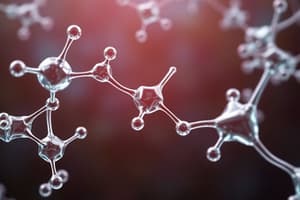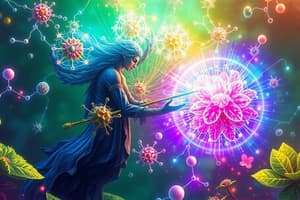Podcast
Questions and Answers
Which of the following is NOT a primary characteristic of eukaryotic cells?
Which of the following is NOT a primary characteristic of eukaryotic cells?
- Linear DNA
- Presence of membrane-bound organelles
- Cell wall made of peptidoglycan (correct)
- A well-defined nucleus
Hydrophobic molecules are readily soluble in water.
Hydrophobic molecules are readily soluble in water.
False (B)
Briefly explain the significance of the 'transition state' in enzyme-catalyzed reactions.
Briefly explain the significance of the 'transition state' in enzyme-catalyzed reactions.
The transition state is an unstable, high-energy intermediate state during a reaction where the substrate is most susceptible to chemical alteration.
The process of copying DNA into RNA is called ________.
The process of copying DNA into RNA is called ________.
Match each term associated with cellular respiration to its description:
Match each term associated with cellular respiration to its description:
Which of the following components is NOT a part of the endomembrane system?
Which of the following components is NOT a part of the endomembrane system?
Anabolic reactions release energy and break down complex molecules into simpler ones.
Anabolic reactions release energy and break down complex molecules into simpler ones.
What is the role of DNA polymerase in DNA replication?
What is the role of DNA polymerase in DNA replication?
The process where cells engulf substances from their surroundings by forming vesicles is known as ________.
The process where cells engulf substances from their surroundings by forming vesicles is known as ________.
Match each phase of mitosis with its description:
Match each phase of mitosis with its description:
Which of the following describes Mendel's Law of Segregation?
Which of the following describes Mendel's Law of Segregation?
X-linked genes are only expressed in females.
X-linked genes are only expressed in females.
Briefly describe the role of tRNA in translation.
Briefly describe the role of tRNA in translation.
The energy currency of the cell, which powers most cellular activities, is ________.
The energy currency of the cell, which powers most cellular activities, is ________.
Match each energy-related term with its description:
Match each energy-related term with its description:
Which mode of inheritance involves the expression of both alleles in a heterozygote?
Which mode of inheritance involves the expression of both alleles in a heterozygote?
Mitochondrial DNA is inherited from both the mother and the father.
Mitochondrial DNA is inherited from both the mother and the father.
Describe the function of a selectively permeable cell membrane.
Describe the function of a selectively permeable cell membrane.
_______ is a type of diffusion where water moves across a selectively permeable membrane from an area of higher water concentration to an area of lower water concentration.
_______ is a type of diffusion where water moves across a selectively permeable membrane from an area of higher water concentration to an area of lower water concentration.
Match the following scientists with their contribution to cell theory:
Match the following scientists with their contribution to cell theory:
Flashcards
Energy
Energy
The capacity to cause change or to perform work.
Kinetic Energy
Kinetic Energy
Energy associated with motion.
Potential Energy
Potential Energy
Energy that matter possesses because of its location or structure.
Chemical Energy
Chemical Energy
Signup and view all the flashcards
ATP
ATP
Signup and view all the flashcards
First Law of Thermodynamics
First Law of Thermodynamics
Signup and view all the flashcards
Second Law of Thermodynamics
Second Law of Thermodynamics
Signup and view all the flashcards
Entropy
Entropy
Signup and view all the flashcards
Exergonic Reactions
Exergonic Reactions
Signup and view all the flashcards
Endergonic Reactions
Endergonic Reactions
Signup and view all the flashcards
Enzyme
Enzyme
Signup and view all the flashcards
Substrate
Substrate
Signup and view all the flashcards
Active Site
Active Site
Signup and view all the flashcards
Activation Energy
Activation Energy
Signup and view all the flashcards
Phototrophs
Phototrophs
Signup and view all the flashcards
Chemotrophs
Chemotrophs
Signup and view all the flashcards
Autotrophs
Autotrophs
Signup and view all the flashcards
Heterotrophs
Heterotrophs
Signup and view all the flashcards
Metabolism
Metabolism
Signup and view all the flashcards
Catabolism
Catabolism
Signup and view all the flashcards
Anabolism
Anabolism
Signup and view all the flashcards
Study Notes
- The final exam for BIO 120 is on Tuesday, April 22 at 4pm in 1101 KHS.
- 1/3 of the exam will cover Chapters 14-15, and 2/3 will be cumulative over the rest of the semester.
Chapter 1: Chemical and Cellular Foundations of Life
- Key vocabulary includes: Bacteria, Archaea, Eukarya.
Chapter 2: Molecules of Life
- Key vocabulary includes: Valence electron, Covalent bond, Carbon, Ionic bond, Polar, Nonpolar, Hydrophilic, Hydrophobic, Hydrogen bond, and Cohesion.
- Essential skill: Using a periodic table to determine the number of protons, neutrons, and electrons in an element, as well as the number of valence electrons.
- Important to know: List the 4 organic molecules.
Chapter 3: Cells, Membranes, and Homeostasis
- Key vocabulary includes: Cell theory, Membrane Proteins, Phospholipid Layers, Cell membrane, Homeostasis, Selectively permeable, Diffusion, Passive transport, Osmosis, Active transport, Cell wall, Cytoplasm, Vesicle, Endomembrane system, Nuclear envelope, Ribosome, Endoplasmic reticulum, Golgi apparatus, Lysosome, Mitochondria, and Chloroplasts.
- Understand the differences between plant cells, animal cells, and prokaryotic cells.
- Identify the parts of a cell and describe their functions.
Chapter 4: Nucleic Acids and Information Flow
- Key vocabulary includes: Deoxyribonucleic acid (DNA), Ribonucleic Acid (RNA), Nucleotide, Mutation, Transcription, Translation, Gene, and Messenger RNA (mRNA).
Chapter 5: Molecular Structure of Proteins
- Key vocabulary includes: Protein, Amino Acid, and Peptide bond.
Chapter 6: Making Life Work
- Key vocabulary includes: Exergonic, Endergonic, Enzyme, Transition state, Activation energy (EA), Phototroph, Chemotroph, Autotroph, Heterotroph, Metabolism, Catabolism, Anabolism, Energy, Kinetic energy, Potential energy, Chemical energy, ATP, First law of thermodynamics, Second law of thermodynamics, and Entropy.
Chapter 7: Cellular Respiration
- Know the chemical equation for cellular respiration.
- Explain the reactants and products of cellular respiration and its importance to the cell and the organism.
Chapter 8: Photosynthesis
- Key vocabulary includes: Chlorophyll.
- Know the chemical equation for photosynthesis.
- Explain the reactants and products of photosynthesis and its importance to both plants and animals.
Chapter 10: Cell and Tissue Form
- Key vocabulary includes: Tissue, Organ, Cytoskeleton, Cilia, Extracellular Matrix, Connective tissue, and Collagen.
Chapter 11: DNA Replication and Cell Division
- Key vocabulary includes: Autosome, Cell division, DNA replication, Cell cycle, Binary fission, Mitosis, Cytokinesis, Chromosome, Interphase, DNA polymerase, Karyotype, Homologous chromosomes, Haploid, Diploid, Sister chromatids, Centromere, Prophase, Mitotic spindle, Prometaphase, Metaphase, Anaphase, Telophase, and Cancer.
- Identify the phases of mitosis.
Chapter 14: Meiosis and Mendelian Inheritance
- Key vocabulary includes: Sexual reproduction, Gametes (germ cells, sex cells), Meiotic cell division, Meiosis I, Meiosis II, Prophase I, Crossing over (chiasma), Prometaphase I, Metaphase I, Anaphase I, Telophase I, Prophase II, Prometaphase II, Metaphase II, Anaphase II, Telophase II, Nondisjunction, Hybridization, Monohybrid, True breeding, Heterozygous, Homozygous, P₁ generation, F₁ generation, F₂ generation, Dominant, Recessive, Allele, Principle of Segregation, Punnett square, Incomplete dominance, Codominance, Probability, Phenotype vs Genotype, Epistasis, Pedigree, and Mendel’s 2 Laws.
- Identify the phases of meiosis.
- Perform a monohybrid cross on a Punnett Square.
Chapter 15: Sex Chromosomes, Linked Genes, and Organelle Inheritance
- Key vocabulary includes: Sex Chromosomes (X Chromosome and Y Chromosome), Autosomes, X-linked genes, Linked genes, Genetic map, Y-linked genes, haplotype, and Mitochondrial DNA.
- Know the characteristics of the X and Y chromosomes.
- Understand the effects of X-linked and Y-linked genes.
- Mitochondria and chloroplast DNA have their own genomes.
- Mitochondrial DNA in humans and other mammals shows maternal inheritance.
- Y-linked genes and Mitochondrial DNA can be used to trace human ancestry and migration.
Studying That Suits You
Use AI to generate personalized quizzes and flashcards to suit your learning preferences.




